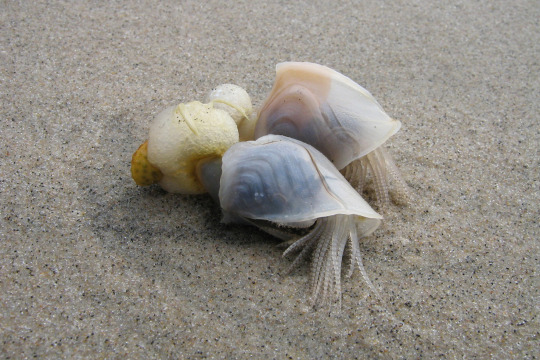#Dosima fascicularis
Text
Creature Awaits #241
Each week I plan to feature an amazing creature, admiring God's fantastic artistry. Hopefully it’ll brighten someone’s day to see something new and interesting if they haven’t seen it before. : )

(Beautiful photograph taken by WestPark (CC BY-NC-ND 2.0 Deed))
Buoy Barnacles
Scientific Name: Dosima fascicularis
Region: Temperate waters across the Atlantic and Pacific
Size: About a .47"-.78" (~1.2cm-2cm) long shell portion
Interesting Notes: If unable to find a suitable floating surface to attach itself to, this delicate and unique barnacle secretes a gas-filled cement, creating its own natural float. It is the only known barnacle to do this. This structure is the pale yellow shape, similar in appearance to expanding foam, visible at left in the photo above. (Hopefully the little guys pictured found their way back to the sea after this photograph was taken! : ) )
#creatureawaits#beautiful animals#elegant animals#interesting animals#translucent animals#Buoy Barnacles#Dosima fascicularis
1 note
·
View note
Video
undefined
tumblr
HEY HELP
my mum got this video down on the beach this morning and we have no idea what it is.
After many reverse searches, I’ve determined it to be a Dosima fascicularis.
BUT Dosima have tentacle-like things.


Maybe it’s just holding it’s tentacles close together but I don’t know!
So if anyone has any other ideas hmu.
9 notes
·
View notes
Text

Scientists have discovered marine animals living on plastic debris in an area of the open ocean dubbed “the Great Pacific Garbage Patch”
A buoy barnacle, Dosima fascicularis, viewed from the side, with the aboral white floating at the water’s surface.
Credit…Denis Rieck
Pacific Ocean garbage patch is immense plastic habitat - BBC News
14 notes
·
View notes
Text
The graptolites of Abereiddy Bay
The graptolites of Abereiddy Bay
Graptolites are curious fossils that are common in Lower Palaeozoic rocks where other types of fossils are lacking. The word ‘graptolite’ comes from Greek words that mean ‘writing’ (graptos) and ‘stone’ (lithos), and refer to the fact that graptolite fossils look like pencil marks on stone, partly because they’re flat and partly because of the iridescence of many specimens when freshly exposed.…
View On WordPress
#Didymograptus murchisoni#Dosima fascicularis#graptolites#Palaeozoic#prosicula#Pterobranchs#Silurian
0 notes
Photo


Buoy Barnacle (Dosima fascicularis)
...a species of lepadid goose barnacle that boasts a cosmopolitan distribution, with a preference for temperate seas. True to its common name adult D. fascicularis will hang downwards from the water surface, held up by a float, and is carried along by currents filter feeding along the way. Larval D. fascicularis are planktonic and must attach to a float (usually flotsam) for metamorphosis into the adult form. However, the adults are eventually capable of using their own float, and are usually seen in aggregations of many individuals all using the same float.
Dosima fascicularis was formerly placed in the genus Lepas but is now placed in its own monotypic genus Dosima. Dosima is distinguished from Lepas by the exceptional brittleness of its exoskeleton and by the form of the carina.
Classification
Animalia-Arthropoda-Crustacea-Maxillopoda-Cirripedia-Pedunculata-Lepadidae-Dosima-D. fascicularis
Images: Notafly and Keith Hiscock
#Buoy Barnacle#Dosima fascicularis#Barnacle#Science#Crustacea#Cirripedia#Maxillopoda#Penduculata#Lepadidae#Dosima#Worldwide#Ocean#Arthropoda
392 notes
·
View notes


